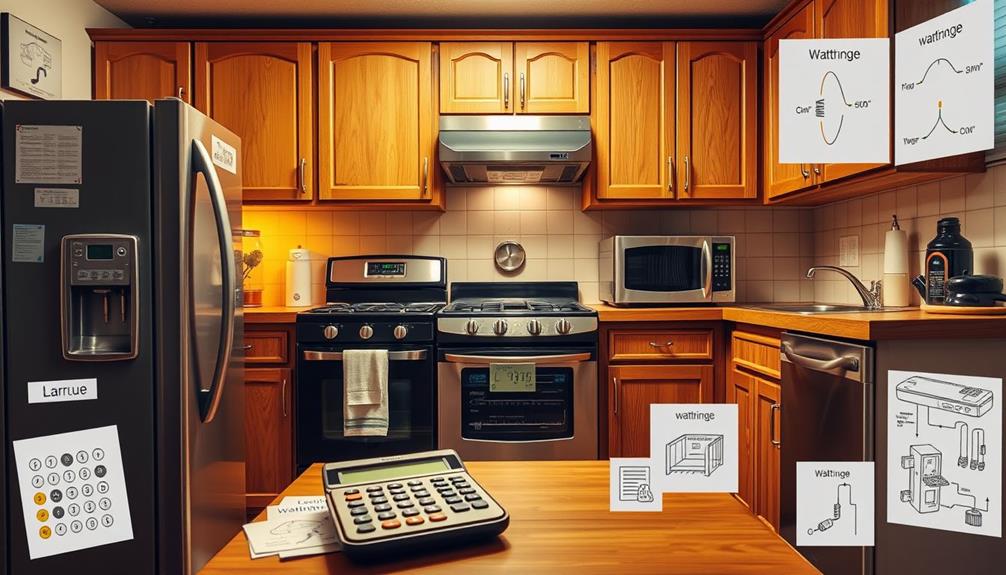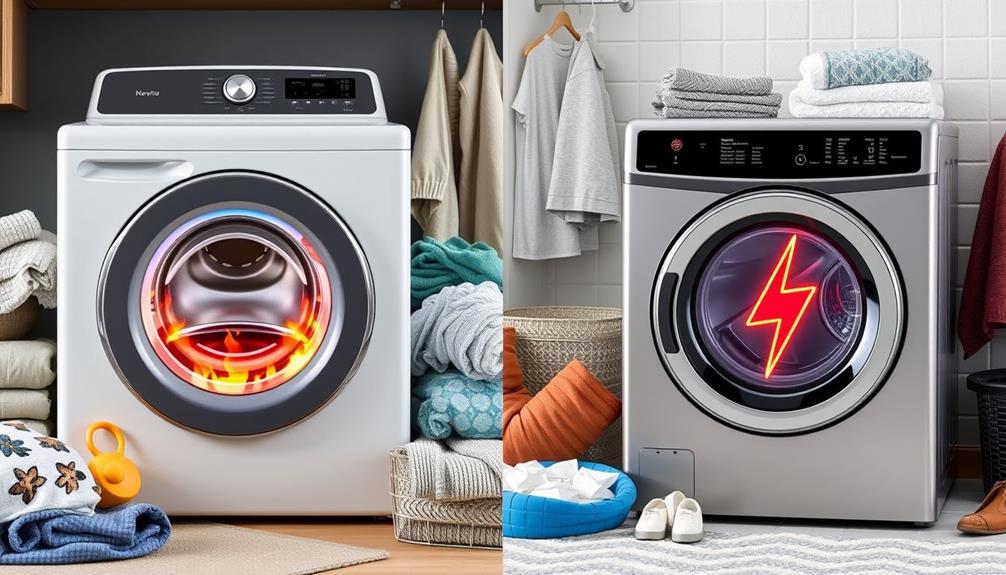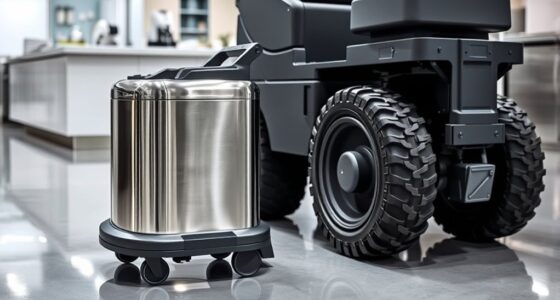To determine the total amperage required for your kitchen appliances, start by checking the wattage ratings on each appliance’s nameplate. Use the formula Amps (A) = Watts (W) ÷ Volts (V); for example, if an appliance uses 1,200 watts on a 120-volt circuit, it draws 10 amps. Then, add up the amperage of all appliances you plan on using simultaneously, making sure the total does not exceed 12 amps on a 15-amp circuit to avoid overload. Remember to include a safety margin of at least 20%. Understanding these calculations is crucial for maintaining a safe kitchen—explore more essential tips to optimize your setup!
Key Takeaways
- Identify the wattage of each appliance using nameplates or manuals for accurate calculations.
- Use the formula Amps (A) = Watts (W) ÷ Volts (V) to determine amperage for each appliance.
- Sum the amperage of all appliances expected to operate simultaneously to find total load.
- Ensure total amperage does not exceed 12 amps on a 15-amp circuit for safe operation.
- Incorporate a 20% safety margin in load calculations to prevent circuit overload and enhance safety.
Understanding Circuit Capacity
When you're dealing with kitchen appliances, understanding circuit capacity is vital for safety and efficiency. Your home's circuits are typically rated at 15 amps, meaning they can support a total load of up to 1,800 watts on a 120-volt circuit.
To calculate the amperage your appliances require, you'll use the formula: Amperage (A) multiplied by Voltage (V). This helps guarantee you don't exceed the circuit capacity. Additionally, consider the impact of air quality on your kitchen environment; using an air purifier can improve overall well-being by reducing allergens and harmful particles the importance of air purifiers.
Appliances operate on either 120 volts or 240 volts, so knowing their voltage ratings is critical for accurate calculations. Keep in mind that to maintain a safe electrical service, you should only use up to 80% of the circuit's total capacity. For a 15-amp circuit, that means keeping your load below 12 amps.
Certain high-load appliances, particularly those with motors, may need dedicated circuits. These dedicated circuits help prevent circuit overload and comply with local electrical codes, guaranteeing your kitchen remains safe and functional.
Key Electrical Measurements
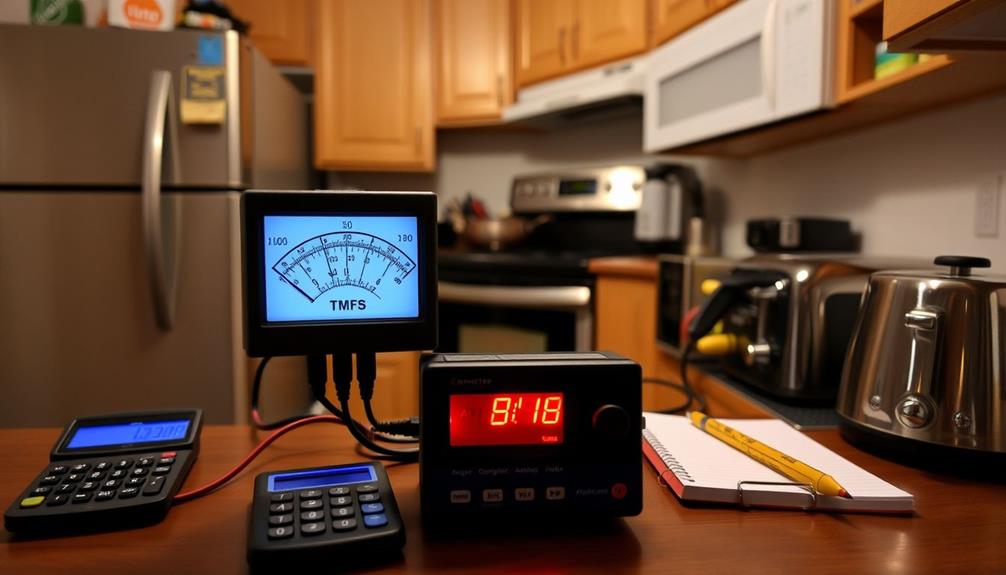
Key electrical measurements are essential for understanding how your kitchen appliances operate safely and efficiently. When you're working with electricity, you'll often encounter three key metrics: amps (A), volts (V), and watts (W). Amps indicate the flow of electricity, while volts represent the pressure, and watts measure the total power consumed. You can calculate wattage using the formula Watts = Amps x Volts. Proper HVAC maintenance also plays a fundamental role in guaranteeing that your home's electrical systems are functioning at peak performance alongside your appliances.
In most households, standard appliances typically run on 120 volts, while larger appliances may require 240 volts. This difference greatly influences their amperage needs. For example, a standard 15-amp circuit can handle an electrical load of up to 1,800 watts (15A x 120V).
It's essential that the total wattage of your connected appliances doesn't exceed this limit, as it could trip the circuit breaker.
To guarantee safe operation, check the nameplate on each appliance for its voltage and amperage ratings. Understanding these ratings helps you calculate the total amps needed when using multiple devices simultaneously.
If you're unsure about your calculations, consult a licensed electrician for expert advice to prevent any electrical hazards.
Calculating Total Amperage
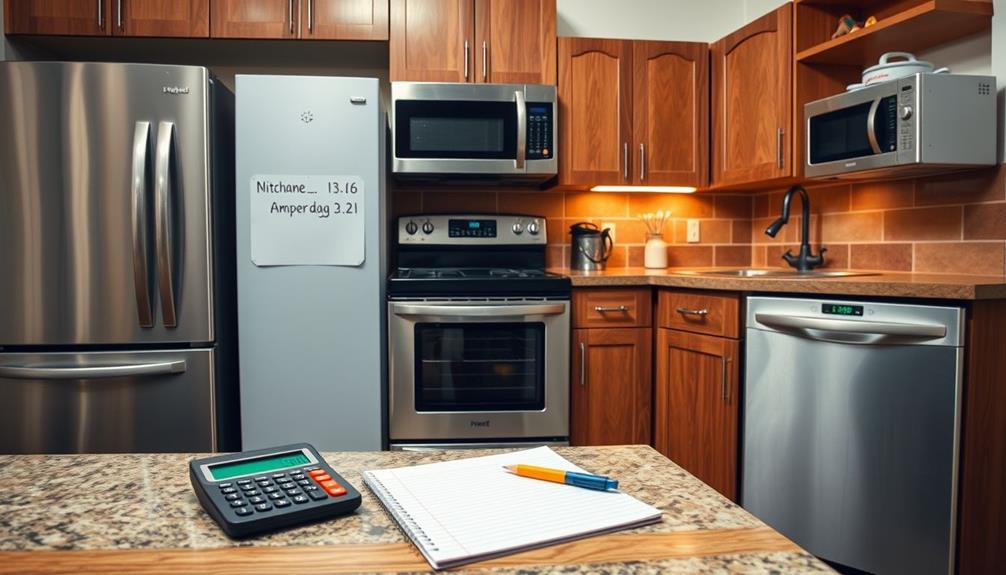
Calculating the total amperage for your kitchen appliances is vital to guarantee your electrical system can handle the load safely. Start by identifying the wattage of each appliance, which you can find on the nameplate or in the manual. For instance, appliances like garage door openers often have specific wattage requirements that can impact your calculations.
Use the formula: Amps (A) = Watts (W) ÷ Volts (V). For example, if you have an appliance that uses 1,200 watts on a 120-volt circuit, it draws 10 amps (1,200 W ÷ 120 V = 10 A).
Next, sum the amperage of all appliances that might be used simultaneously to determine the total amperage load in your kitchen. This is especially important for commercial kitchen equipment, where multiple devices often run at once.
Always consider the capacity of the circuit. For example, if you have a circuit rated at 15 amps, the maximum load should be approximately 12 amps (15 A x 0.80) to prevent overload.
This guarantees your electrical system operates safely without tripping breakers, making it vital to accurately calculate the total amps needed for your kitchen appliances.
Safety Margins in Load Calculation

Guaranteeing a safe kitchen environment requires attention to safety margins in load calculations. When you calculate the total amperage for your household appliances, it's vital to incorporate a safety margin of at least 20%.
For instance, if your calculated load is 1,800 watts, aim to keep your maximum load at 1,440 watts, which is 80% of the circuit capacity. This practice helps prevent overloads on your electrical system and reduces the risk of tripping circuit breakers.
Understanding the energy efficiency of your appliances can also contribute to better load management, as certain devices, like heat pumps, can greatly reduce energy consumption economic and environmental impact.
By adhering to these safety margins, you accommodate unexpected high-draw instances that can occur during appliance startup surges. Regularly evaluating the load of your kitchen appliances is essential for maintaining both safety and efficiency in your cooking environment.
Awareness of circuit limits not only enhances the performance of your electrical system but also considerably lowers the chances of electrical hazards.
Ultimately, maintaining safety margins in load calculations will help guarantee reliable operation. So, before plugging in that new appliance, double-check your calculations and make sure you're well within those safety margins.
Your kitchen's safety depends on it!
Energy Efficiency Considerations
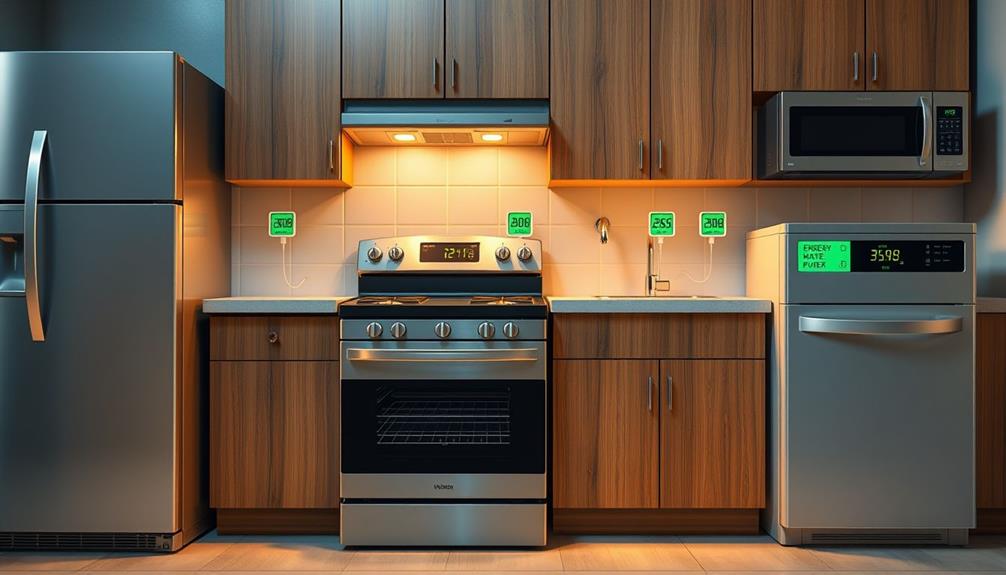
Energy efficiency plays a significant role in managing the total amperage for your kitchen appliances. By opting for energy-efficient appliances, you'll notice they typically consume less watts of power, which can drastically reduce the amps needed for your circuits. This allows for better load management and minimizes the risk of circuit overload.
Additionally, integrating renewable energy sources like geothermal energy can further enhance your kitchen's energy efficiency. Consider upgrading your electrical system to accommodate Energy Star-certified appliances. These appliances can cut energy usage by 10-50%, depending on the type, which directly lowers your overall amperage requirements.
Additionally, switching to LED lighting can decrease energy consumption by up to 75%, further lowering the amperage draw compared to traditional incandescent bulbs.
In commercial kitchens, where energy demands can be high, implementing high-quality insulation and energy-efficient practices can be a game-changer. This approach helps minimize the electrical load of heating and cooling appliances, indirectly affecting the amperage needed for kitchen operations.
Frequently Asked Questions
How to Calculate the Amperage of Appliances?
To calculate an appliance's amperage, divide its wattage by the voltage. Check the nameplate for wattage, then use the formula: Amps = Watts ÷ Volts. This'll help you understand each appliance's electrical needs.
How Many Amps for Kitchen Appliances?
When considering amps for kitchen appliances, remember smaller ones like toasters typically need around 10-15 amps, while larger appliances such as ovens or refrigerators may require 20 amps or more for safe operation. Always check specifications.
How Do You Calculate Amp Requirements?
To calculate amp requirements, you divide watts by volts. You gather the wattage and voltage ratings, you perform the calculation, and you sum the amps for all appliances that might operate simultaneously for safety.
How Do You Calculate Electrical Load for Home Appliances?
To calculate your electrical load for home appliances, gather each appliance's wattage, sum them up, and divide by your circuit's voltage. Don't forget to factor in a 20% safety margin to avoid overload.
Conclusion
In summary, calculating the total amperage for your kitchen appliances is essential for safety and efficiency. By understanding circuit capacity and key electrical measurements, you can avoid potential overloads and guarantee your appliances run smoothly. Remember, it's better to be safe than sorry; think of it as giving your electrical system a well-deserved check-up. Keep those safety margins in mind, and you'll create a harmonious kitchen environment where every appliance can shine.
